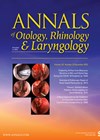
Journal Reviews
Organoids in otolaryngology
This interesting review article summarises the status as well as future prospects of organoid technology in our field. Organoids are a mass of cells which are typically cultured in vitro with 3D technology. They simulate miniature tissues and organs and...
Is Gamma Knife Surgery effective for intracanalicular vestibular schwannomas?
Vestibular schwannomas (VSs) are rare, occurring in approximately five per 100,000 adults a year. In circa 8% of cases, the VS is contained within the internal auditory canal, i.e. intracanalicular (iVS). Although radiosurgery is a recognised treatment modality for VSs,...
Strength of evidence in otolaryngology research – do women make the difference?
Clinicians around the world understand the need for research and publication of gathered evidence to inform practice and improve patient outcomes. The introduction of the Oxford Centre for Evidence-based Medicine (CEBM) Levels of Evidence guideline in 2011, has been invaluable...
Outcomes of larger glottic cancer volumes treated with radiotherapy
T3 glottic cancer is characterised as vocal cord fixation and/or invasion into pre-epiglottic, post-cricoid, paraglottic spaces and/or within the inner cortex of thyroid cartilage. Traditionally, laryngectomy was considered the primary option to treat T3 laryngeal glottic cancers until other options...
Make food thy medicine!
This is a useful paper emphasising how diet affects health and various ENT conditions. We have known for many years the power of food as medicine. We also know that what we eat can affect our bodies in multiple ways...
Corticosteroid prescribing in ENT - are we at risk of being sued?
Of medications leading to malpractice claims, corticosteroids comprise the third most common. They are used widely and have a significant side-effect profile: hypertension, lipodystrophy, diabetes, avascular necrosis of the femoral head, peptic ulceration and psychiatric reactions to name but a...
Age is not an issue in sinus surgery
We have an increasingly aged population, and hence older and older patients are presenting with sinonasal issues and the potential need for endoscopic sinus surgery (ESS). The authors sought to identify if older patients (age >70) have more complications post...
Eosinophilic or not eosinophilic: dupilumab seems to work
Chronic rhinosinusitis with nasal polyps (CRSwNP) is a type 2 inflammation with interleukin (IL)-4, IL-13, and IL-5. Tissue eosinophilia in nasal polyps dramatically increased over a 10-20-year period. Classification of the severity of eosinophil status is expected to lead to...
Not as rare as we think? Silent sinus syndrome incidence on CT heads
It is relatively uncommon to come across a case of silent sinus syndrome (SSS), but not as rare as the prevalence in the literature might suggest – the authors of this study note that only 100 cases are reported in...
Why do some people get their smell back so quickly after a COVID infection whilst others don’t?
Of course, we are all too familiar with the effect that COVID-19 infection has on our sense of taste and smell, but why do most patients get better whilst, for many, the misery lingers on and on? This paper looks...
Serum biomarkers for CRSwNP
This cross-sectional comparative study looked at 50 patients with nasal polyps who, at the time of diagnosis, also had a blood test evaluating serum total IgE, IL-17 and Pentraxin-3. The study assesses whether these blood markers are useful in the...
CRSwNP and smell – is it just the obstruction?
Anosmia and hyposmia are symptoms of CRS both with and without nasal polyps and can significantly affect quality of life. The nature of anosmia/hyposmia is thought to be both sensory-neural and conductive. These authors studied a mouse model in which...
















